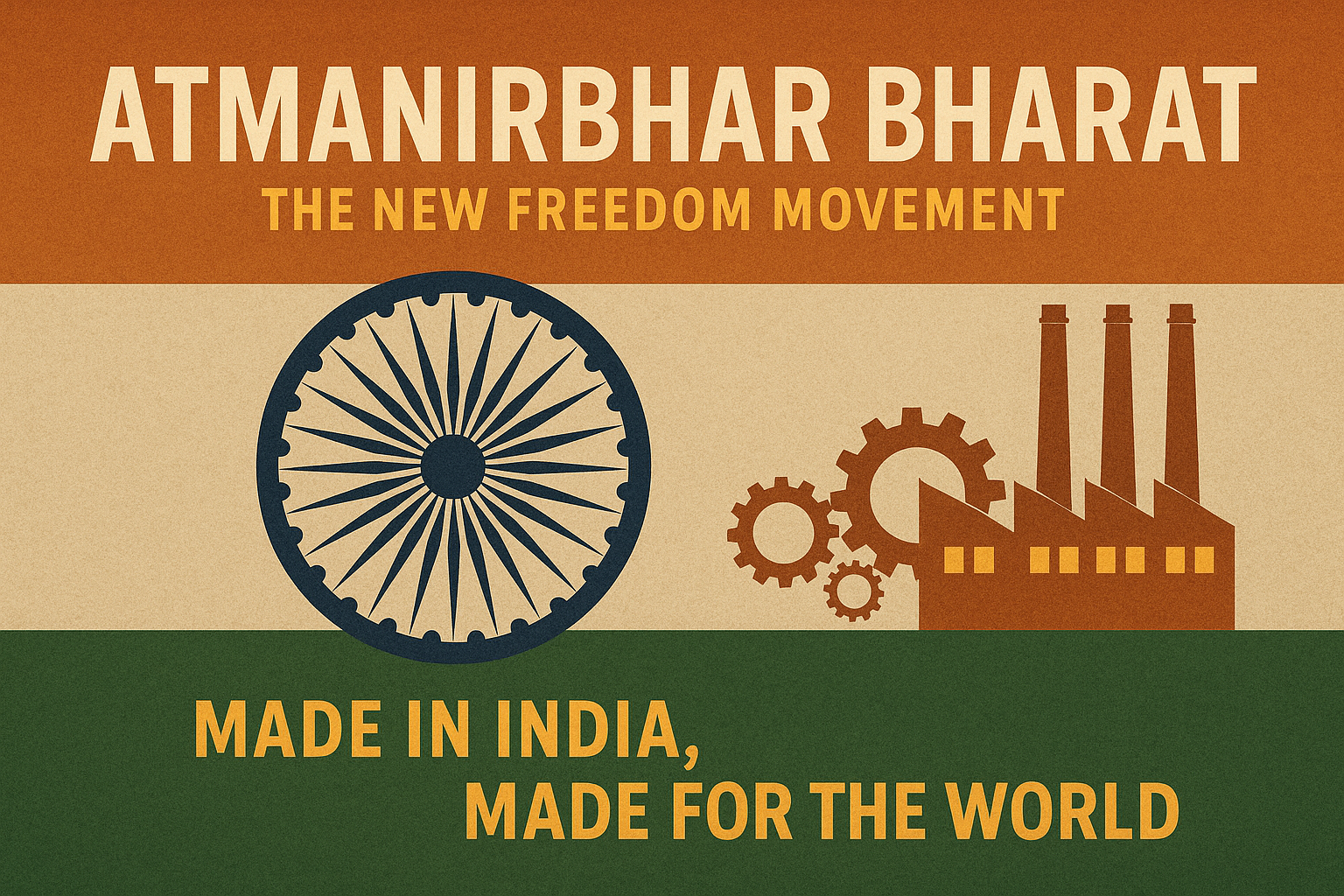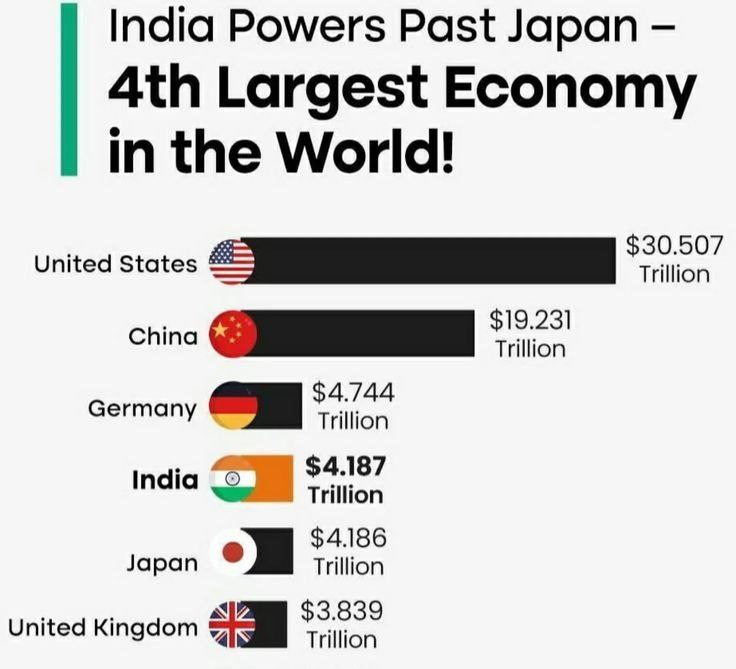Disclaimer
“This article is meant for informational and inspirational purposes only. It reflects the author’s perspective on India’s innovation, startups, and economic growth. It is not intended as political commentary, investment advice, or a critique of any country or organization.”
“Atmanirbhar Bharat is the new freedom movement”
Yes, you are reading it right.
It’s been 78 years since we got independence, 15th August 1947, the day our freedom fighters sacrificed their today for our tomorrow, the day when the fire inside Indian hearts burned hotter than the sun, the day when the mighty British Empire got shaken by the roar of a people who refused to bend, the day when 340 million Indians looked at the horizon, not with fear, but with hope.
Something started that day: “The Indian Dream.”
In 1947, the GDP of our country was 27 billion dollars, or 2.7 lakh crore rupees. Today, it has crossed 4 trillion dollars. We are a country of 1.3 billion people, the youngest nation in the world.
The world has changed. The global economy is no longer dominated by a single superpower; it is now multipolar.
In a unipolar world, nations could rely on the dominant power’s protection or market access. In a multipolar world, survival and growth depend on your own economic strength, because influence, security, and opportunity flow to whoever can create value at scale.
This Independence Day, let’s talk about the new freedom movement: Atmanirbhar Bharat. About how Indian startups are not just building for India, but for the world. About the lessons today’s founders and tomorrow’s leaders must carry forward. Because freedom isn’t just something we earned in 1947, it’s something we must protect, strengthen, and expand every single day.
During Independence, 75% of the country depended on agriculture. Today, we have expanded our vision to the industrial revolution. We are growing as the next manufacturing hub. India is starting to stand on its own feet.
Let’s dive in.

Atmanirbhar Bharat – The New Freedom Movement
What does Atmanirbharta exactly mean?
It is the ability of a country to withstand all kinds of crises and still stand strong and independent.
Imagine a factory. To run, it needs resources: power, water, employees, raw materials, and customers. If any one of these resources is cut off, the factory will stall operations. If the issue isn’t resolved, one day, the factory shuts down.
The same applies to a country. There are geopolitical pressures, trade deals, sanctions, tariffs, high-interest loans, inflation, and more.
If a global power wanted to weaken a country’s economy, they could limit access to the key resources that country depends on. This can push a nation into higher debts, recession, inflation, and difficult living conditions, making independent growth nearly impossible.
You see, many smaller nations today face challenges in maintaining economic stability due to global dependencies and market pressures. In some cases, these pressures limit their ability to make independent decisions, which can affect citizens livelihoods. This highlights why building resilience and self-reliance is so important for any country.
Now, you understand why Atmanirbharta is critical.
If India strengthens its resources, controls inflation, and builds a resilient economy, it can stand firm in tough situations. Our country can make decisions based on the interests of its citizens, not under external pressures. This is why I call Atmanirbhar Bharat the new freedom movement.
Made in India, Made for the World
Did you ever feel that India is not blitzscaling in technology? Well, that is changing.
Gone are the days when people saw India only as a land of agriculture, textiles, and spices. This is New India. We are now aggressively adopting technology. We are building for the world.
Made in India is a brand that stands for quality, reliability, and innovation.
Why is building for the world important?
Whoever controls trade, controls influence globally. Today, much of global trade is led by China and the U.S. China exports all kinds of products at competitive prices, while America dominates defense equipment and advanced technology exports.
Being a strong exporter is not just important, it is essential. It defines India’s growth trajectory, empowering the country to take bold decisions confidently during adversities.
Benefits of an export-driven economy:
- Manufacturing large quantities or building global tech products attracts local and foreign investors.
- These companies create jobs, contribute taxes, and help the government invest in infrastructure, poverty alleviation, and strategic sectors.
- Local economies grow, real estate develops, and more people gain access to basic amenities.
- Research opportunities expand, talent rises, and communities grow.
- Education, discipline, and collective ambition strengthen as a result.
Made in India, Made for the World – Success Stories
Akash Missile System: An indigenous missile system with 100% accuracy against threats within a 30km range. It is cost-effective, designed by DRDO, and has attracted international interest, showcasing India’s defense capabilities.
UPI: More than just technology, it’s a revolution. UPI allows seamless payments without reliance on global networks like Visa or Mastercard. Developed by NPCI in 2016, it is now adopted in Singapore, France, UAE, Sri Lanka, and more, handling billions of transactions per month with robust security.
Zoho & Freshworks: Zoho serves 180+ countries, simplifying corporate workflows. Freshworks became the first Indian company listed on NASDAQ. Both are made in India, for the world.
These examples highlight India’s potential and global rise. The list is far longer if we dig deeper.

The New India
Experts rate India highly for four key factors:
- Resilient Consumer Base: Aspirational consumers drive demand for high-quality products and services. India is a top market for global FMCG brands and tech giants.
- Broad Investment Landscape: India is developing rapidly, exploring sectors like agritech, biotech, spacetech, defense, green energy, EV’s and more. Nifty 50 has grown from 6,100 in 2010 to 24,600 today, a testament to investor confidence.
- Dynamic Workforce: With an average age below 30, Indian youth are ambitious, talented, and willing to work hard.
- Innovation Potential: India has the talent, resources, and drive to dominate future sectors.
This is just the beginning. India is on its way to becoming a global trade leader, a peace-builder, and a true Vishwa Guru.
The Gap We Still Need to Bridge
After thorough research and listening to people’s opinions, I’ve understood a few concerns that our startup founders and leaders must solve.
We are the fastest-growing economy, yet there are areas where we are still lacking.
I want to raise this concern with a question, so you can realize the opportunity here:
We don’t have a search engine. We are relying on Google for browsing. Google alone made $340+ billion in revenue in 2024. That number is bigger than the GDP of some countries.
What if we build our own search engine, for our people, and for the world?
Today, if sanctions gets imposed Taiwan, South Korea, or Japan, you immediately see the global chip market affected, and phone prices rise.
What if India starts dominating semiconductor manufacturing?
Artificial Intelligence is taking over the world. Big countries are developing their own LLM models. What happens if India builds its own LLM? The country’s data stays within, securing user privacy and sensitive information.
Our country has built amazing systems. Now it is time to leverage them. We have the power to develop everything indigenously. We must reduce overreliance on foreign SaaS tools.
Deep-tech, biotech, and AI are high-capital, long-term sectors. They require time before revenue starts flowing. Our big VC firms should take bold bets on such companies, tomorrow, they could become India’s kingpins.
Innovators and Entrepreneurs Are the New Freedom Fighters
Our jawans sacrifice their lives for our present and future. Top officials work tirelessly, giving up family time and personal life. Many top businessmen invest huge amounts of capital in under-recognized but high-impact niches. Everyone at the top of the graph is giving their best to boost our economy.
I believe any small contribution toward the country’s growth from us is patriotism. Every successful startup today is a win for India.
Indians are CEOs of top global MNCs. This shows the capability of our people. For years, due to lack of opportunity, resources, or awareness, people went abroad to pursue careers.
But not anymore. India is the next Silicon Valley. Youth need to wake up. We have to file more patents, export more goods, invest in growing companies, and innovate more. We don’t need to replicate Western products. We need to play to our strengths. We build the best-quality goods at the most affordable price. We have to custom-build for our markets, and very soon, the world will start adopting them.
5 Tangible Ways for Startups & Young Entrepreneurs to Drive India’s Next Freedom Movement
If you are a young entrepreneur reading this, here are a few tangible ways to build for India and the world:
- Break the Monopoly of Foreign Platforms: Building Indian alternatives in every sector should be prioritized. We must dominate every field and keep our money, security, and data within our borders.
- Own the Supply Chain End-to-End: Earlier, I mentioned: the one who controls trade, controls the world. We should build global products with Indian raw materials. From sourcing to final packaging, the entire supply chain should be fulfilled in India. If our companies become the driving force of the world, the world will feel our absence when we underperform. Policies will start getting shaped based on our requirements.
- Solve Boring but Massive Problems: Sewage waste, water cleanliness, climate change, chemical food production, these problems are not flashy, but they are huge. If you understand these markets, start solving them. The potential is limitless.
- Invest in Deep-Tech, Not Just Apps: Hardware, biotech, material science, and space tech take years to mature but create defensible moats and contribute to global growth.
- Make Global-First Indian Brands: “Global-first” doesn’t mean focusing on foreign markets from day one. It means thinking, designing, and aiming for a global audience from day one. Build in India, but with ambition to serve the world. Companies like Google, OpenAI, Perplexity, Apple, Microsoft, Oracle, Zoho, and Freshworks all started by solving local problems with global thinking, and eventually conquered the world markets.
Conclusion
Even as some doubted India’s growth, global companies like S&P which is a renowned credit watcher upgraded India’s credit rating, signaling trust and investment-worthiness.
Bhagat Singh, Subhash Chandra Bose, Rani Lakshmi Bai, Mahatma Gandhi, Sardar Vallabhbhai Patel, and Bal Gangadhar Tilak gave India political freedom. Today, our innovators and entrepreneurs are driving technological and economic freedom.
India is rising. It is resilient, innovative, and ready to take its place on the global stage. Every contribution, every idea, and every startup strengthens the nation. India has the talent, the resources, and the ambition to grow steadily while making a positive impact in the world.
Keep up the spirit. Work with integrity. Contribute to the country. Be part of the Indian Dream. Because,
India is the future.
Thank you for taking the time to read this piece. Your curiosity and support drive the spirit of innovation and growth in India. Together, we can build a future where Indian ideas, products, and startups shine on the global stage. Jai Hind!
thehustleweek.com is here to remind you every week that you’re not alone on this journey. Don’t waste another year stuck in imagination; start taking action today. Each week, theHustleWeek aims to unlock your potential by providing valuable insights that inspire and empower you to think differently.
As a community of hustlers, theHustleWeek aims to positively impact your life. If you found this article useful, please share it and leave your thoughts in the comments section. Your feedback encourages us to create more curated content. Feel free to explore our other blogs as well.





